Difference between revisions of "Portal:Featured Image Of The Week"
From Asylum Projects
M-Explorer (talk | contribs) |
M-Explorer (talk | contribs) |
||
| Line 1: | Line 1: | ||
{{FIformat | {{FIformat | ||
| − | |Image= | + | |Image= tewksburyMA003.jpg |
|Width= 600px | |Width= 600px | ||
| − | |Body= | + | |Body= The [[Tewksbury State Hospital|hospital was established]] in 1852 as one of three state almshouses needed to help care for the unprecedented influx of immigrants into Massachusetts at that time. The almshouses were the Commonwealth's first venture into caring for the poor, a duty which had previously been carried out by the cities and towns. Opened on May 1, 1854 with a capacity for 500, the almshouse population grew to 668 by the end of the first week, and to over 800 by May 20th. By December 2, 1854, 2,193 "paupers" had been admitted. Nearly 90% of these listed European countries as their birthplace. The almshouse reported having 14 employees at that time, and was spending 94.5 cents per week per resident. |
}} | }} | ||
Revision as of 04:15, 5 November 2023
Featured Image Of The Week
The hospital was established in 1852 as one of three state almshouses needed to help care for the unprecedented influx of immigrants into Massachusetts at that time. The almshouses were the Commonwealth's first venture into caring for the poor, a duty which had previously been carried out by the cities and towns. Opened on May 1, 1854 with a capacity for 500, the almshouse population grew to 668 by the end of the first week, and to over 800 by May 20th. By December 2, 1854, 2,193 "paupers" had been admitted. Nearly 90% of these listed European countries as their birthplace. The almshouse reported having 14 employees at that time, and was spending 94.5 cents per week per resident.
